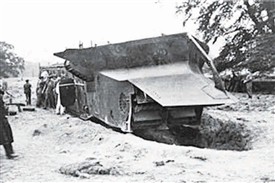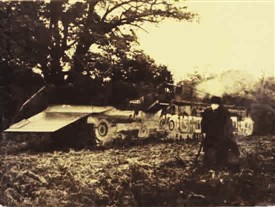When 'Nellie' Came to Clumber

The Officer's Mess at Clumber
P. Ingall

'Nellie' in action
P. Ingall

'Nellie' with the shadowy figure of Winston Churchill on the right
P. Ingall

The Lime tree Avenue at Clumber is very much the same today as when parts of 'Nellie' were transported down it
P. Ingall
Winston Churchill's innovative war machine tested in Notts
By Philip Ingall
In 1916 it is reported that Winston Churchill advanced his idea for a revolutionary new machine designed to allow the infantry to advance towards the German lines in relative safety.
Although Churchill lacked mechanical knowledge, he had a clear understanding of what he wanted. He saw this machine as one of very few aggressive initiatives by the allies during the Phoney War—the first few months of the war, characterised by a lack of real fighting. The machine he had envisioned would be capable of breaking the stalemate of trench warfare that had developed during World War I and would thereby avoid the atrocious conditions and high casualty rate that had resulted.
The prospect of such fighting in World War II was made even worse by the construction of the Siegfried Line (or West Wall): a continuous belt of barbed-wire entanglements, minefields, anti-tank obstacles, forts and trenches – the strength of which was greatly exaggerated by German propaganda.
Churchill's trench cutters would cross no man's land in the dark and, protected by an artillery barrage, the attacking force would advance in the relative safety of the cut trench and then burst upon the surprised defenders. The idea was not pursued.
Idea becomes reality
In 1939, with the start of World War Two, Churchill again advanced the idea that a fleet of his “moles”, as he called them would be able to advance from their base digging a wide trench as they went to allow the infantry to advance behind them. The noise that they would make was extremely loud but it was envisaged that a simultaneous heavy artillery barrage would drown the machinery noise and allow the ”moles” to advance and surprise the enemy lines.
Churchill summoned the Director of Construction with the orders to put the idea into reality. Like the tank in the First World War such a machine had never been constructed or even designed and in 1939 the Naval engineers went to Lincoln to work with engineers from Ruston Bucyrus who were the principal manufacturers of earth moving machinery, manufacturing various sizes of excavators.
Working model
They produced a working model some 4ft long and if given the go ahead said they could produce some 200 of the machines by March 1941. Churchill showed the model, code named “White Rabbit No 6 “, to Chief of the General Staff General Sir Edmund Ironside and other military chiefs who thought it had merit and offered “endless possibilities. The manufacturer of a prototype was commissioned and at this stage the responsibility was transferred from the navy to the Ministry of Supply which created a special branch called the Department of Naval Land Equipment. Why a seafaring service should have its name in the title seems a mystery. The prototype was code named “NLE Tractors” which soon came to be known as “Nellie”.
Clumber Park chosen
Built by Ruston Bucyrus at Lincoln there was a discussion as to where it would be put through its paces and Clumber Park was chosen. A former home of the Dukes of Newcastle, it was a victim of the Great Depression which forced the abandonment of the mansion and it was demolished in 1938. When Nellie came to Clumber the house had disappeared but some outbuildings remained including the walled garden with its huge greenhouse, The Gothic Revival Chapel built by the 7th Duke still stood by the lakeside. The 3,000 acres of open land in the park was deemed suitable with much of it out of sight of prying eyes.
In that remote corner of the park a detachment of Royal Engineers set up their camp and worked alongside the Ruston Bucyrus staff.
And here lies a coincidence. One of the Royal Engineer sappers was Bill Saunders, my stepfather and one of Ruston Bucyrus’s engineers was Eric Browne. In 1941 they had worked side by side. It was a decade later that they became reunited when my mother and stepfather met the parents of my first wife, Eric and Lillian Browne and the men spent some considerable time reminiscing on their experiences with “Nellie” in Clumber Park.
Gargantuan
“Nellie” was truly gargantuan and in action resembled what one supposes was the naval connection when it was described as a ship ploughing through dirt instead of water. To design, produce and test a machine of such immense proportions took nearly two years. In great secrecy the test of the prototype was held in a remote corner of Clumber Park on July 25th, 1941, and again in August for the Army General Staff. In November 6th, 1941. Churchill travelled from London by train and car but had to walk the last few hundred yards through boggy ground to the site of the test. Churchill had refused the Wellington boots set aside for him and arrived, with mud caked shoes and dirt on his trousers, a cigar clamped firmly in his mouth and in a thoroughly irritable mood, for his first glimpse of the great “mole” machine upon which he had pinned so much hope.
“Nellie” was 77' long, 6' 6" wide, 8' high and made in two sections. The main section, driven on caterpillar tracks, looked like a greatly elongated tank and weighed 100 tons. The front section, weighing another 30 tons, was capable of digging a trench 5' deep and 7' 6" wide. It comprised a plough which cut the top 2' 6" of the trench, and 'pick and shovel' cutting cylinders which excavated the bottom 2' 6". Conveyors carried the spoil to the top of each side of the trench to create 3' parapets. Nellie could move at just over half a mile an hour, removing some 8,000 tons of spoil in the process.
The machine performed adequately and, as was his habit, Churchill inspected everything in sight but was unusually quiet during the demonstration. Like a giant scythe, Nellie dug her enormous trench. Afterwards, he walked along the inside of the trench while above him someone carried a ladder for him to climb up. Ignoring the ladder, Churchill walked to the end of the trench, climbed out and, saying little, went on his way.
Although the test showed that such a machine would work, in reality it became almost a “Star Wars” fantasy. One of the problems it faced was that, as it passed the pieces it had trenched, the walls were susceptible to collapse and this would hinder the troops following it. Also the machine itself filled with fumes and Eric Browne, who had ridden inside one during the trials described the heat, noise and fumes as so intense they could well overcome the crew if they were inside for any great length of time. Its sheer weight also made it impossible to ford rivers, circumnavigate obstacles or even climb hills.
No part to play
It also followed that, with the experience of how the German army had overcome France, it obvious that the gargantuan “Nellie” would play no part in a war where static front lines had ceased to exist especially with the German Blitzkrieg tactics of its Panzer divisions. The flat fields of Flanders that Churchill had experienced during World War One were a different kettle fish to the conditions under which the Second World War would be fought. Winston Churchill had an extremely fertile imagination but in the grand scheme of things they were scarcely more than a fantasy of that fertile mind in relation to the reality of what was then modern warfare.
Project cancelled
In May 1943, the War Office officially cancelled the project, thus ending the strange saga of Nellie. “I am responsible but impenitent,” Winston Churchill later declared. Many of the Clumber Park detachment of Royal Engineers, including Bill Saunders, went on to serve in Burma and Eric Browne returned to Ruston Bucyrus who were busily building hundreds of tanks (some 60% of their war time production). As a young boy in Lincoln I used to witness with other boys, what to us was the excitement of seeing these monsters of war being loaded on to flat railway trucks outside their factory and off to the war effort.
First World War tank
P. Ingall
Coincidentally this was just a couple of hundred yards from the factory gates of agricultural machinery manufacturers William Foster where First World War tanks, some 100 years ago this year, were manufactured and invented by Sir William Tritton, managing director of Fosters together and Major W G Wilson.
Despite the presence of factories engaged in the war effort in both of those wars, Lincoln received very little in the way of bombing. Perhaps the landmark Lincoln Cathedral was too good a landmark and the location within the county of so many RAF airfields.
Wonderful ideas
“Nellie” was one of those “wonderful” ideas that were conceived during the war but unlike the Barnes Wallis bouncing bomb, the Battle of Britain, Reginald Mitchell designed, Spitfire or the devastating and war ending atom bomb it was never used in anger. Only five of the machines were built. Four were scrapped when the war ended and the fifth, possibly the pilot machine that was tested at Clumber, was scrapped in the early 1950s.
Of those 1940s events at Clumber Park there is nothing to see that would bring back memories. My stepfather took me to the area where the trials took place but the years had brought what is now a shallow undulating ground back to normality and one can only imagine the monster as it ploughed its half mile an hour desecration of that part of the former Duke of Newcastle’s 3,000 acres of parkland.
Originally left to the people of Worksop by the late Duke Clumber Park became part of the National Trust in 1946 and is now a leading tourist attraction in the area.
(with acknowledgement to the various sources from which this article was gathered).